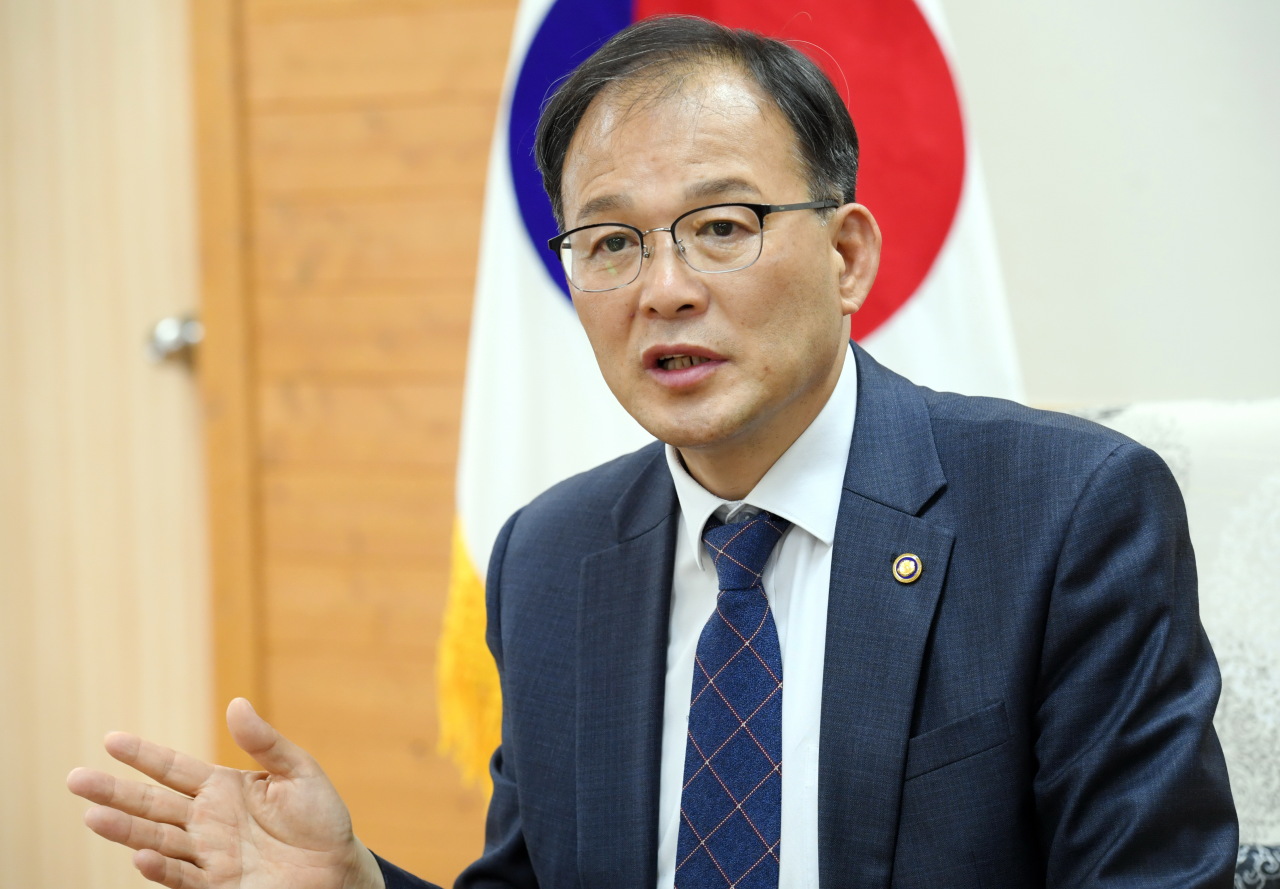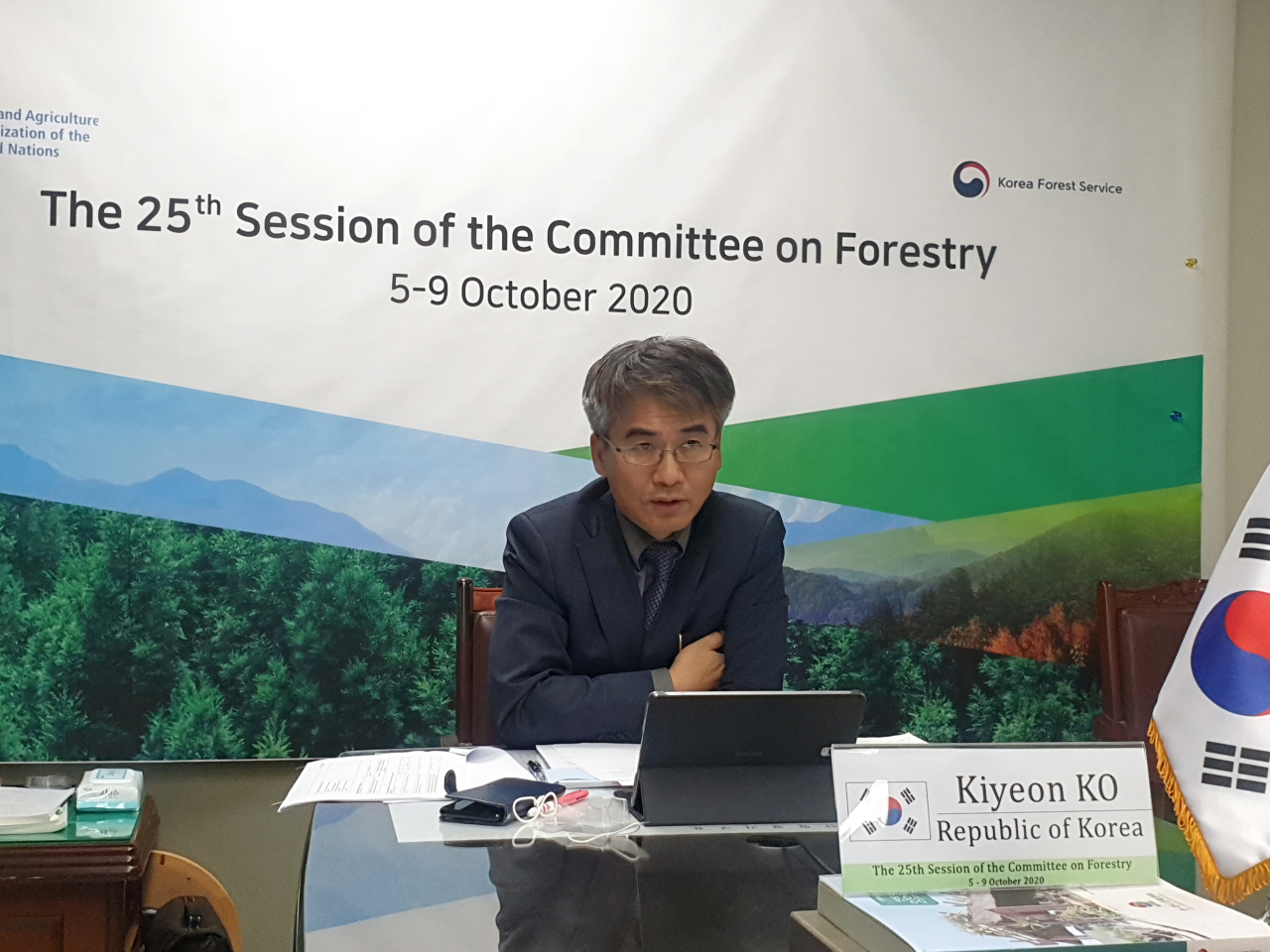KFS helps Korea see greatest forest growth in world
By Kim Byung-wookPublished : Oct. 15, 2020 - 16:25

The Korea Forest Service said Thursday that South Korea has witnessed the world‘s greatest growth rate in the volume of trees over the past 25 years, according to a report announced at a session held on Monday by the United Nations Food and Agriculture Organization’s Committee on Forestry.
UN FAO COFO’s biennial session is one of the world’s biggest forestry events that brings together heads of forest services and other senior government officials to share the results of their efforts in forest management.
According to the UN FAO COFO’s report “Forest Futures in the Asia-Pacific Region,” which was also the debate topic of the session on Monday, Korea saw an increase of 196 percent in the average volume of trees planted per hectare from 1990 to 2015, followed by Poland, Denmark, England, Slovenia and Japan.
In terms of increase in the sheer volume, Korea ranked third by recording an increase of 98 cubic meters per ha from 50 cubic meters per ha to 148 cubic meters per ha, followed by Belgium and England, which recorded an increase 86 cubic meters per ha and 75 cubic meters per ha, respectively.
UN FAO COFO’s biennial session is one of the world’s biggest forestry events that brings together heads of forest services and other senior government officials to share the results of their efforts in forest management.
According to the UN FAO COFO’s report “Forest Futures in the Asia-Pacific Region,” which was also the debate topic of the session on Monday, Korea saw an increase of 196 percent in the average volume of trees planted per hectare from 1990 to 2015, followed by Poland, Denmark, England, Slovenia and Japan.
In terms of increase in the sheer volume, Korea ranked third by recording an increase of 98 cubic meters per ha from 50 cubic meters per ha to 148 cubic meters per ha, followed by Belgium and England, which recorded an increase 86 cubic meters per ha and 75 cubic meters per ha, respectively.

“The report proves that Korea’s forest management efforts after 1990 have been word-class, on top of the country’s pride in planting 10 billion trees during the “Keep Forest Green” campaign that ran between 1973 to 1987. Compared to previous reports, this one measured figures per unit area, which makes Korea’s achievements all the more meaningful,” said Ko Ki-yeon, the director general of International Affairs Bureau at the KFS.
For this year’s UN FAO COFO session, which was held Oct. 2-12 via video conference, Shin Won-seop, a professor at Chungbuk National University and the former head of the KFS, chaired the forest committee. The session discussed the World Forestry Congress as part of the agenda, which will be held in next May.
The KFS also added that studying the cases of Slovenia and Poland, which posted a three-digit surge in tree volumes of 116 cubic meters per ha and 102 cubic meters per ha in the same period, would bring meaningful lessons that would be helpful in restoring forests in North Korea.
Moreover, the KSF called for the government to provide support for forests.
“Korea has reached 158 cubic meters per ha in tree volume as of 2018, but to aim for 300 cubic meters per ha, state subsidies for crops harvested in mountains are essential, as 67 percent of mountains are privately-owned by more than 2 million owners,” a KSF official said.
To support rural communities, the Korean government offers subsidies to crops harvested in the fields, but not to those harvested in the mountains.
Above all, the KSF said a more scientific approach will be necessary for forest management in the future.
“The reason Korea could enjoy a 196 percent growth compared to Japan’s 50 percent growth was because forests in Korea had been in a poor shape. To continue the growth rate, a more scientific forest management strategy is required,” the KSF official said.
By Kim Byung-wook and Lee Kwon-hyoung (kbw@heraldcorp.com) (kwonhl@heraldcorp.com)
For this year’s UN FAO COFO session, which was held Oct. 2-12 via video conference, Shin Won-seop, a professor at Chungbuk National University and the former head of the KFS, chaired the forest committee. The session discussed the World Forestry Congress as part of the agenda, which will be held in next May.
The KFS also added that studying the cases of Slovenia and Poland, which posted a three-digit surge in tree volumes of 116 cubic meters per ha and 102 cubic meters per ha in the same period, would bring meaningful lessons that would be helpful in restoring forests in North Korea.
Moreover, the KSF called for the government to provide support for forests.
“Korea has reached 158 cubic meters per ha in tree volume as of 2018, but to aim for 300 cubic meters per ha, state subsidies for crops harvested in mountains are essential, as 67 percent of mountains are privately-owned by more than 2 million owners,” a KSF official said.
To support rural communities, the Korean government offers subsidies to crops harvested in the fields, but not to those harvested in the mountains.
Above all, the KSF said a more scientific approach will be necessary for forest management in the future.
“The reason Korea could enjoy a 196 percent growth compared to Japan’s 50 percent growth was because forests in Korea had been in a poor shape. To continue the growth rate, a more scientific forest management strategy is required,” the KSF official said.
By Kim Byung-wook and Lee Kwon-hyoung (kbw@heraldcorp.com) (kwonhl@heraldcorp.com)

















![[KH Explains] Hyundai's full hybrid edge to pay off amid slow transition to pure EVs](http://res.heraldm.com/phpwas/restmb_idxmake.php?idx=652&simg=/content/image/2024/04/18/20240418050645_0.jpg&u=20240418181020)

![[Today’s K-pop] Zico drops snippet of collaboration with Jennie](http://res.heraldm.com/phpwas/restmb_idxmake.php?idx=642&simg=/content/image/2024/04/18/20240418050702_0.jpg&u=)